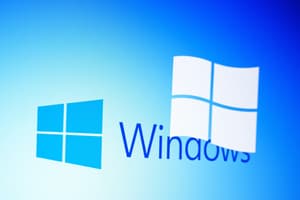Podcast
Questions and Answers
Which of the following is NOT a critical task in server management and administration?
Which of the following is NOT a critical task in server management and administration?
- Performing system backups
- Conducting market research (correct)
- Managing user permissions
- Monitoring system performance
What benefit does virtualization provide when using Windows Server technology?
What benefit does virtualization provide when using Windows Server technology?
- Improves energy consumption
- Increases physical server count
- Enhances hardware compatibility
- Allows creation of multiple virtual machines (correct)
Which component is essential for maintaining server security over time?
Which component is essential for maintaining server security over time?
- Regular patching and updates (correct)
- Server capacity planning
- User satisfaction surveys
- Service level agreements
When deploying server components via cloud platforms, what is a primary benefit?
When deploying server components via cloud platforms, what is a primary benefit?
Why is managing user permissions vital in a business setting?
Why is managing user permissions vital in a business setting?
What is one of the primary functions of Windows Server?
What is one of the primary functions of Windows Server?
Which feature of Windows Server enhances its security?
Which feature of Windows Server enhances its security?
What role does Active Directory primarily serve in Windows Server?
What role does Active Directory primarily serve in Windows Server?
Which characteristic of Windows Server allows it to handle increasing demands?
Which characteristic of Windows Server allows it to handle increasing demands?
Which of the following roles in Windows Server allows centralized access to files?
Which of the following roles in Windows Server allows centralized access to files?
Which management tool feature does Windows Server provide?
Which management tool feature does Windows Server provide?
What is a primary feature of the Web Server role in Windows Server?
What is a primary feature of the Web Server role in Windows Server?
Which feature of Windows Server facilitates communication between servers and clients?
Which feature of Windows Server facilitates communication between servers and clients?
Flashcards
Server Management
Server Management
Managing and administering servers, including monitoring performance, preventing threats, and updating software.
Server Virtualization
Server Virtualization
Creating virtual machines on a single server allowing for more flexibility and efficient use of resources.
Cloud Support
Cloud Support
Integration with cloud services for scalable and flexible resource usage.
Server Security
Server Security
Signup and view all the flashcards
User Permissions
User Permissions
Signup and view all the flashcards
Windows Server
Windows Server
Signup and view all the flashcards
Security Features
Security Features
Signup and view all the flashcards
Scalability
Scalability
Signup and view all the flashcards
Management Tools
Management Tools
Signup and view all the flashcards
Active Directory
Active Directory
Signup and view all the flashcards
File Server
File Server
Signup and view all the flashcards
Print Server
Print Server
Signup and view all the flashcards
Web Server
Web Server
Signup and view all the flashcards
Study Notes
Windows Server Overview
- Windows Server is a line of server operating systems developed by Microsoft. It's designed for businesses and organizations that require robust server-side software for managing network, applications, websites, and data storage.
- These systems are typically employed to run various server-based functions, such as file storage, email hosting, web serving, database management, and virtual machine hosting.
Key Features and Functionality
- Enhanced Security: Windows Server incorporates advanced security features to protect sensitive data and systems. This includes features such as role-based access control, firewalls, intrusion detection systems, and encryption protocols.
- Scalability and Flexibility: The platform is designed for scalability, allowing an increase in resources as demands grow on the system. Various configurations and components can be tailored to meet specific operational needs.
- Management Tools: Windows Server comes with a suite of management tools to monitor, troubleshoot, and administer the server. These tools often employ graphical user interfaces (GUIs) and command-line options, depending on tasks and user preferences.
- Networking Support: It provides extensive networking capabilities, allowing seamless communication and data exchange between servers, clients, and external systems. Features such as network file sharing, domain controllers, and routing & remote access are common.
Different Editions and Roles
- Windows Server offers different editions tailored for distinct needs. These editions may vary in functionality, features, and licenses.
- Essential Roles of Windows Server include:
- Active Directory: This role facilitates user authentication and management across a network. It is a primary role in large organizations with extensive user bases.
- File Server: This role allows centralizing files and data for network access.
- Print Server: This role allows multiple users to easily share and manage printers across the network.
- Web Server: For hosting websites and web applications. The more advanced versions often provide greater control and resource allocation.
- Mail Server: For hosting email services.
- Application Server: For hosting and running applications that may require greater processing power or specialized configurations.
- These different roles and editions allow organizations to choose the specific server capabilities they need, matching operational requirements and budgets.
Server Management and Administration
- Server management and administration are crucial tasks within an organization.
- Efficient management strategies, including monitoring system performance, and taking proactive measures against threats, are important.
- Software updates, system backups, and scheduled maintenance tasks are critical to support server stability and reliability.
- User permissions that are closely managed are essential in a business setting.
Virtualization and Cloud Support
- Windows Server readily supports virtualization technologies, allowing the creation of virtual machines within a single server. This provides a more efficient and flexible approach.
- The software commonly integrates with cloud services and solutions provided by other companies to facilitate cloud-based functionalities.
- Server components can be deployed via cloud platforms to allow for scalability and flexibility of resource usage.
Security Considerations
- Maintaining server security is a continuously evolving process.
- A robust approach that involves regular patching, security audits, access controls for users, and threat prevention mechanisms is essential.
- Active monitoring and management of any security protocols that are in place are essential to prevent, or mitigate any potential attacks.
Studying That Suits You
Use AI to generate personalized quizzes and flashcards to suit your learning preferences.




